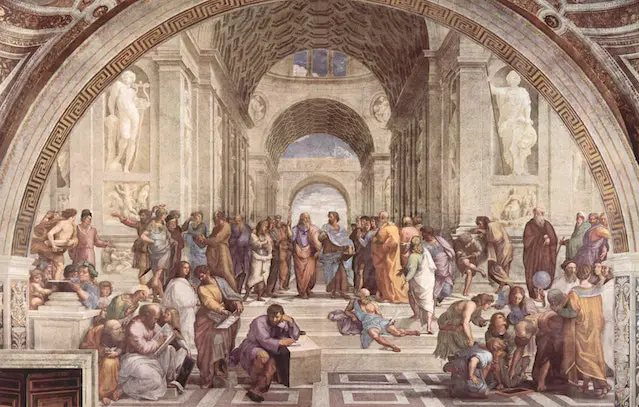
In ancient history, there are a vast number of fascinating facts and stories that have been shared over time.
From the grand empires of Rome to the mysterious cultures of Mesoamerica, there is a plethora of knowledge we can learn about our ancestors.
Ancient history is full of political intrigue, groundbreaking technological advancements, wars, and incredible feats of architecture.
Here are just some of the amazing ancient history facts to inspire your curiosity and admiration!
Fact #1: The Egyptian pyramids were built over 4,500 years ago
Built between 2550 to 2490 BCE, the Great Pyramids of Giza are some of the most iconic structures in world history.
Standing at an impressive height of 481 feet, these monuments were constructed using a combination of stones and limestone mortar with copper chisels and hammers.
The pyramid’s interior chambers, passages, and galleries were designed to protect the Pharaoh’s body and possessions, while the exterior was adorned with symbols of power and strength.
The precise construction methods used to build these structures remain a mystery to this day, making them an incredible feat of engineering and craftsmanship.
To this day, they are still one of the world’s most impressive ancient monuments and a testament to the creativity of our ancestors.
- Read also: 10 Norse Mythology Facts That You Should Know
- Read also: Top 10+ Black History Facts You Need to Know
Fact #2: The Great Wall of China was built more than 2,000 years ago
The Great Wall of China is an impressive series of fortifications that stretch for over 5,500 miles across northern China.
The construction of the wall began in the 7th century BC and continued intermittently for several centuries until it was finally completed in the 17th century AD.
It served as a protective barrier against invaders, with watchtowers located along its length to alert troops of any potential threats.
Made from stone, brick, earth and wood, this incredible feat of engineering and craftsmanship is a testament to the ingenuity of our ancestors.
Despite its impressive length, much of the wall remains well-preserved today and stands as one of the world’s most iconic ancient monuments.
Fact #3: The Roman Empire spread across three continents

The Roman Empire at its peak stretched across three continents – Europe, Africa and Asia.
This mighty empire was ruled by Julius Caesar in the 1st century BC and lasted until its fall in 476 AD.
It vastly influenced European culture, introducing a unified language, legal system, engineering feats such as aqueducts and bridges, and many other aspects of civilization that are still used today.
During its reign, the Roman Empire was one of the most powerful forces in world history, and its influence is still felt across our modern world.
Fact #4: The Colossus of Rhodes stood at an impressive height of 32 meters
Built around 280 BC, the Colossus of Rhodes was a gigantic statue that stood at the entrance to the port city on the island of Rhodes.
Dedicated to the Greek sun god Helios, the statue was said to have been 32 meters tall and constructed from bronze plates held together by iron bars.
Although it only stood for 56 years before it was destroyed in an earthquake, its impressive scale has made it one of the most legendary ancient monuments in history.
Its memory lives on today as a symbol of the remarkable achievements our ancestors were capable of.
Fact #5: The Mayan civilization was advanced in mathematics and astronomy
The ancient Mayans are often remembered for their mysterious monuments, but they were also incredibly advanced in mathematics and astronomy.
They developed the Long Count calendar system, which allowed them to accurately track dates and events far into the future, and they also made significant advances in mathematics such as calculating the square root of 2.
They were also incredibly adept observers of the night sky, accurately tracking the movements of planets and stars.
Today, their achievements still inspire admiration and awe for the skill and ingenuity of our ancestors.
Fact #6: The Great Library of Alexandria was one of the world’s largest and most influential libraries

The Great Library of Alexandria was an incredible achievement for its time, housing some of the earliest works of literature and knowledge from around the ancient world.
Built in Egypt in the 3rd century BC, it was said to contain over 700,000 scrolls, making it one of the world’s largest libraries.
This library was home to famous scholars such as Euclid, Archimedes, and Eratosthenes, and its influence helped spread knowledge and learning around the ancient world.
Although destroyed in antiquity, its legacy lives on as a lasting symbol of our ancestors’ intellectual achievement.
Fact #7: Stonehenge is one of the most mysterious ancient monuments
Stonehenge is an incredible feat of engineering and craftsmanship, but it is also one of the most mysterious ancient monuments.
Built-in England between 3000 BC and 2000 BC, its purpose remains a mystery to this day.
There are many theories as to why Stonehenge was built, ranging from being an astronomical calendar to a site of religious worship, but the truth behind this ancient monument remains elusive.
Its mysterious nature has made it an enduring symbol of our ancestors’ ingenuity and determination to solve the world’s greatest mysteries.
Fact #8: The Great Wall of China is the longest wall in human history
The Great Wall of China was built over 2000 years ago to protect the Chinese Empire from invasion.
Stretching for over 6,000 km, it is considered to be the longest man-made structure in human history.
Built by conscripted soldiers and workers, the wall incorporated defensive features such as watchtowers, fortifications, and gates to keep out attackers.
Today, its vast size is a testament to the determination of our ancestors to defend their homeland against intruders.
Fact #9: The Parthenon was one of the most iconic ancient Greek monuments

The Parthenon is one of the most iconic monuments from ancient Greece, built in 447 BC on the Acropolis of Athens.
Dedicated to the goddess Athena, it was an incredible feat of architecture and engineering, featuring elegant columns and sculptures depicting gods and heroes from Greek mythology.
Although damaged by numerous wars and natural disasters over the centuries, its impressive size and beauty still impress visitors today.
This ancient monument is a lasting reminder of the grandeur and sophistication of ancient Greek civilization.
- Read also: How Did Napoleon Die
- Read also: A Journey Through the Most Famous Historical Figures
Fact #10: The Roman aqueducts were a feat of engineering
The Romans were renowned for their engineering feats, and the aqueducts they built throughout the empire are an example of this.
These impressive structures carried fresh water from nearby rivers and springs to cities, often spanning hundreds of miles.
Constructed with arches, tunnels, and bridges, these aqueducts were one of the most impressive accomplishments of the Roman Empire.
Today, they are a testament to the ingenuity and skill of our ancestors.
Overall, these ten facts are just a small part of the immense scale of achievements made by our ancestors.
From exploring the night sky to building some of the world’s most iconic monuments, they have left behind a remarkable legacy that continues to inspire and amaze us today.



